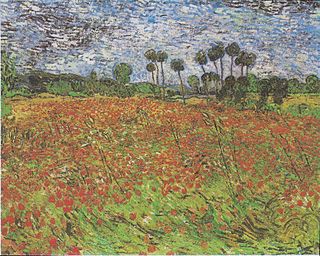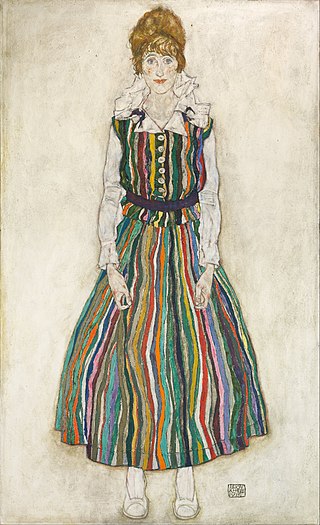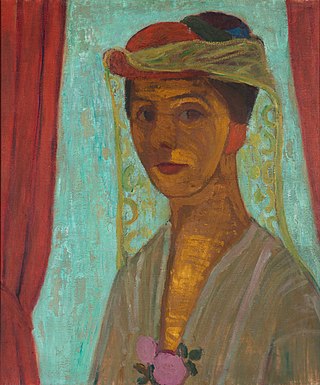
Cubism is an early-20th-century avant-garde art movement that revolutionized European painting and sculpture, and inspired related artistic movements in music, literature, and architecture. In Cubist works of art, the subjects are analysed, broken up, and reassembled in an abstract form—instead of depicting objects from a single perspective, the artist depicts the subject from multiple perspectives to represent the subject in a greater context. Cubism has been considered the most influential art movement of the 20th century. The term cubism is broadly associated with a variety of artworks produced in Paris or near Paris (Puteaux) during the 1910s and throughout the 1920s.

The Kunstmuseum Den Haag is an art museum in The Hague in the Netherlands, founded in 1866 as the Museum voor Moderne Kunst. Later, until 1998, it was known as Haags Gemeentemuseum, and until the end of September 2019 as Gemeentemuseum Den Haag. It has a collection of around 165,000 works, over many different forms of art. In particular, the Kunstmuseum is renowned for its large Mondrian collection, the largest in the world. Mondrian's last work, Victory Boogie-Woogie, is on display at the museum.

Victory Boogie Woogie is the last, unfinished work of the Dutch abstract painter Piet Mondrian, left incomplete when Mondrian died in New York in 1944. He was still working on it three days before dying. Since 1998 it has been in the collection of the Kunstmuseum, in The Hague. It has been said that "Mondrian's life and his affection for music are mirrored in the painting [and that it is] a testimony of the influence which New York had on Mondrian."

Albert Carel Willink was a Dutch painter who called his style of Magic realism "imaginary realism".
The "Sonderbund" — as it is normally called; its complete name being Sonderbund westdeutscher Kunstfreunde und Künstler, and also known as Sonderbund group — was a "special union" of artists and art lovers, established 1909 in Düsseldorf and dissolved in 1916. In its first years, the Sonderbund mounted some landmark exhibitions, successfully introducing French Impressionist, Post-Impressionist and Modern Art to the western parts of Germany.

The Kunstmuseum Basel houses the oldest public art collection in the world and is generally considered to be the most important museum of art in Switzerland. It is listed as a Swiss heritage site of national significance.

The National Gallery is a gallery in Oslo, Norway. Since 2003 it is administratively a part of the National Museum of Art, Architecture and Design.

Johannes Knud Ove Jais-Nielsen was a Danish painter, designer and ceramist, best known for the religious figure groups that he designed for the Royal Copenhagen pottery.

KM21 is a museum for contemporary visual art in The Hague in the Netherlands. The museum was established in 2002 as part of the Kunstmuseum Den Haag. In KM21 work by artists from The Hague, the Netherlands and international contemporaries can be admired at the same time.

In the 1967 Basel Picasso paintings purchase referendum, the people of Basel, Switzerland, voted for the purchase of two paintings by Pablo Picasso, Les deux frères (1906) and Arlequin assis (1923). The referendum took place on 17 December 1967, and the "yes" campaign was supported by the youth of Basel and the local football club FC Basel, among others. Picasso was astonished by the fact that people would vote in favor to buy his art in a majority vote, and invited Franz Meyer, the director of the Kunstmuseum Basel, to see him at his atelier in Mougins, where he presented the "Youth of Basel" with four more of his works.

Poppy Field is an 1890 painting by the Dutch artist Vincent van Gogh, painted around a month before his death during his stay in Auvers-sur-Oise, France. It has been described as "a composition that verges on the abstract" and shows marked difference from a 1888 painting of the same subject that now is in the Van Gogh Museum, in Amsterdam. Spending many years in Germany, the painting now hangs in the Kunstmuseum, in The Hague.

The Red Cloud is an 1907 early painting by the Dutch artist Piet Mondrian. It was painted in 1907. Mondrian completed the painting while staying near Oele, in the east of the Netherlands. One art historian has noted that the "hard colour contrasts and charged, expressive brushwork" is part of Mondrian's evolution towards an abstract painter.

Portrait of Edith (the artist's wife) is a painting by the Austrian artist Egon Schiele. The sitter is Edith Harms, "a middle-class woman from a well established family." It was painted in 1915, during a period of leave for Schiele from the First World War.

Evolution is an early painting by the Dutch artist Piet Mondrian. It was executed in 1911, after the artist had visited Paris. The painting represents a mid-point in Mondrian's journey from realistic landscapes to radical abstraction. Symbolic in form and with stylised lines, it was Mondrian's last painting where he painted a human form. Soon after Mondrian completed the painting, it was exhibited as part of the first Moderne Kunstring exhibition at the Stedelijk Museum in Amsterdam.

Composition with Yellow Lines is an 1933 abstract painting on canvas by Dutch artist Piet Mondrian. While following the grid like structures of his other abstract paintings, it is unusual in omitting the use of any black lines. Indeed, Mondrian's earlier writings on art had stated that any lines in his paintings had to be black; colour was reserved for the filled in rectangles. The painting is equally unusual in that none of the lines meet. He did not paint any further paintings with this design element until his move to New York in 1940.

Self-Portrait with Hat and Veil is a painting by the German Expression painter Paula Modersohn-Becker. It was painted between 1906-7. It has been described as an impenetrable, secret painting: "the artist stands in front of a draped window, her face both in shadow and covered by a veil, doubly concealing the backlit figure from public viewing. Only the deep V-shape of her garment suggests exposure of any kind, and even there the flower held just at the breast both hints at and denies a fuller view."

When One Grows Old is an 1881 Oil-on-canvas painting by Dutch artist Jozef Israëls. The subject of the painting is an old woman warming herself by a fireplace.

Ein Zentrum is a painting by the Russian abstract artist Wassily Kandinsky. It was painted in 1922 or 1923, around 12 years after Kandinsky has established the Der Blaue Reiter movement. It hangs in the Kunstmuseum, in Den Haag, Netherlands.
Arlequin is a 1913 painting by the Spanish artist Pablo Picasso. The painting can loosely be considered a portrait of a harlequin, but through the lens of Picasso's cubist style, where "Picasso paints a figure from several angles at once, dividing it into rectangles and circles." The painting is a considered an example of 'synthetic cubism', a development from Picasso's earlier 'geometric cubism'. Within 'synthetic cubism' elements of collages were included and the image appeared slightly closer to reality than the abstractions of geometric cubism.

The Card Players is a 1916/7 painting by the Dutch artist Theo van Doesburg.


















